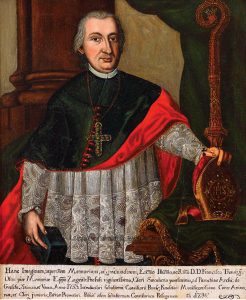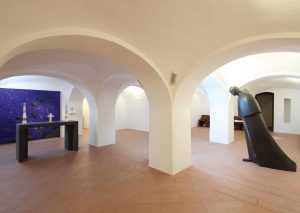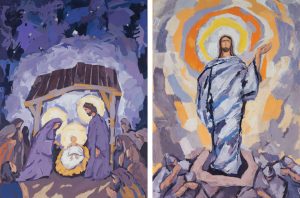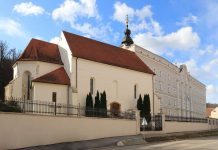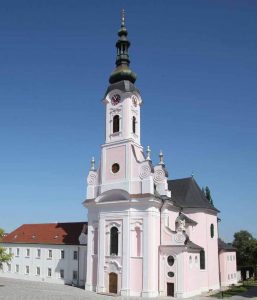 Following the liberation of Slavonia from the Ottoman rule, the present area of the Požega diocese was assigned to the bishopric of Zagreb. It was Franjo Thauszy (bishop of Zagreb, 1751-1769) who invested particular efforts in the spiritual renewal of the region in the mid-18th century. In 1752, he established the Consistorium subalternum and endowed it with administrative authority over the Slavonian part of the diocese. The Jesuits had founded a Gymnasium in Požega as early as 1699 and Bishop Thauszy erected a Seminarium attached to it in 1754 and an Academy for the schooling of priests in 1760.
Following the liberation of Slavonia from the Ottoman rule, the present area of the Požega diocese was assigned to the bishopric of Zagreb. It was Franjo Thauszy (bishop of Zagreb, 1751-1769) who invested particular efforts in the spiritual renewal of the region in the mid-18th century. In 1752, he established the Consistorium subalternum and endowed it with administrative authority over the Slavonian part of the diocese. The Jesuits had founded a Gymnasium in Požega as early as 1699 and Bishop Thauszy erected a Seminarium attached to it in 1754 and an Academy for the schooling of priests in 1760.
The bishop assigned a particularly important role to the new parish church, which he intended to build on the site of a military depot near the Požega fort, purchased in order to accommodate the renewed collegiate chapter of St Peter’s. As the municipal administration opposed his idea, he wrote to Empress Maria Theresa in Vienna and asked for her approval. The empress postponed the renewal of the Chapter to a later date, yet permitted him to build the church, commissioned an architectural design, and offered financial support, which is why the church has St Theresa of Avila as its titular saint. Construction works started in 1756 and three years later, in 1759, the building was ready to the extent that the first Mass could be celebrated there. Its furnishing took another four years. According to the inscriptions on the stone plaque above the main entrance to the Cathedral and the Memorial Book of the parish, the church of St Theresa of Avila was solemnly consecrated by Franjo Thauszy, bishop of Zagreb, on July 24, 1763.
The bishop also donated the main altar with a painting of St Theresa, work of Viennese painter Caspar Franz Sambach, and a pulpit with his own episcopal coat-of-arms. The two side altars – that of St Michael the Archangel, work of an anonymous artist, and that of St John Nepomuk, work of the Viennese academic painter Johann Bander (Iohann; Iohannes Pander) – were donated by Mihajlo Maurović, the parish priest of Kutjevo, and by the Croatian ban Ferenc Nádasdy. Together with the pulpit, they create a harmonious stylistic composition. Another group of baroque furnishing consists of four confessionals, furniture in the sacristy, and the baptistery. The third stylistic group of furnishing consists of the late baroque carved benches.
In the late 19th and early 20th centuries, significant interventions took place in the Cathedral. Its walls and vaulting were decorated by Croatian painters Celestin Medović and Oton Iveković, it obtained a floor paved with ceramic tiles, new furniture, two side altars in the “Tyrolean” style, stained-glass windows, and a new organ, work of Josip Brandl from Maribor.
In the 250 years of the Cathedral’s service to the faithful, the most significant event was the decision of Pope John Paul II in 1997 to establish the Požega diocese and assign a new role to the church of St Theresa: “We raise the church built to God in this place, and dedicated to the honour of St Theresa, to the level and the dignity of a cathedral church, bestowing upon it the rights and privileges due to such churches.”
Thus it became the mother church of western and central Slavonia between the rivers Ilova and Londža, and Sava and Drava, the area covered by the Požega bishopric. It was established as a church that would house the episcopal catedra, from which the bishop would oversee the local congregation as its teacher, priest, and pastor. When the bishop, surrounded by various religious orders and services, presides in the cathedral over the celebration of the Eucharist, then the Church as a unity of faith, hope, and love, built by the resurrected Jesus Christ in the power of his Spirit, is actualized and manifested in this sacral building. In a way, this is clearly reflected in the position of the cathedral in the central city square, where it rises like a vertical axis around which the urban texture circles and grows. These symbolic dimensions are the reason why the cathedral was furnished and decorated with particular attention, in accordance with its function and the mysteries celebrated there. However, it was also in order to house artworks that celebrate the sublime God with their beauty. Even though the church of St Theresa of Avila was originally built as a parish church, its position, exquisite architecture, and valuable artistic decoration made it perfectly suitable to become a cathedral.
After its foundation, the bishopric of Požega first had to build up its basic structures and then, at the tenth anniversary of its activity, it began with the gradual adaptation of the parish church of St Theresa for its new cathedral functions, starting from the equipment. Under the supervision and according to the plans of Milko Puncer, an architect from Osijek, and under the expert conservationist supervision of the Croatian Ministry of Culture, the ruined church floor was substituted through stone slabs and the sanctuary was furnished with a stone altar, a processional cross made of bronze, six large bronze candelabra, and a stand for the Easter candle made by artist Kuzmo Kovačić. A stone ambon and an Episcopal catedra with the coat-of-arms of the diocesan bishop, work of Hrvoje Ljubić, were also installed, all in accordance with the liturgical regulations of the Second Vatican Council. Five new bells produced by the “Grassmayr” company from Innsbruck were added to the old bell in the belfry, and the old, derelict organ in the choir was replaced by a new one with 40 registers, produced by the famous organ maker Wolfgang Eisenbarth from Passau. A staircase was opened up from the main nave into the crypt, which had hitherto been closed, all bones of the priests and citizens buried there during the 18th and the first half of the 19th century were moved to a common tomb, and burial sites were organized for the bishops. On the tenth anniversary of the foundation of the Požega diocese and the ordination of its first bishop on September 27, 2007, a new altar was solemnly consecrated and the renewed cathedral blessed, which instituted it in its due dignity. Since that time, each year the diocese celebrates the Anniversary of the Consecration of the Cathedral, which unites the historical memory of the consecration of the parish church of St Theresa of Avila, the consecration of the new cathedral altar, the foundation of the Požega diocese, and the ordination of its first bishop.
During the past years, the cathedral has been enriched with additional important details, produced by the contemporary Croatian artists. Academic artist Šime Vulas made a wooden tabernacle, placed the statue of Our Lady of Lourdes on a suitable base, and installed wooden Stations of the Cross with tall candelabra below them. In the central part of the side cathedral walls, academic painter Đuro Seder made a large mural of Christ’s birth and resurrection. Following an idea of academic sculptor Marija Ujević Galetović, a part of the crypt under the central nave was arranged as a chapel of Saint John Paul II, founder of the Požega bishopric. A sculpture of the saintly Pope cast in bronze was placed there, likewise work of Ujević Galetović, as well as an altar in grey stone made by Ivan Nestić and candelabra made by Petar Barišić, who also produced the reliquary that now houses the relics of Saint Pope John Paul II, gift of Cardinal Stanislaw Dziwisz, who had long served as the Pope’s secretary. The wall was decorated with a mosaic made by painter Vatroslav Kuliš. At the main entrance to the cathedral, a new bronze gate was placed in 2016: the “Gate to Heaven”, work of Marija Ujević Galetović. The exterior façade of the cathedral was renewed and the smaller entrance to the chapel of “Young Sunday” was adorned with the “Bishopric Gate” made by the same artist to commemorate the foundation of the Požega diocese.
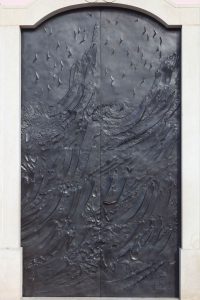 It should be mentioned that, owing to various donations and the efforts of the parishioners, the church of St Theresa of Avila has collected a considerable number of sacral objects during its history, which greatly enriched the Croatian sacral heritage. Among these objects, there are several precious gothic chalices from the 15th and 16th centuries, as well as baroque ones, which include a gift of Empress Maria Theresa from 1763, donated on the occasion of the church consecration along with valuable liturgical vestments. There are also liturgical books, among which three manuscripts from the 17th century, containing musical scores on four lines and with richly decorated initials, take a prominent place. Since the foundation of the Požega bishopric, a number of liturgical objects for pontifical celebrations have been acquired or obtained in donation. These include a crosier, a richly bound evangelistary made by Hrvoje Ljubić, and a chalice designed by Ana Nada Krpelnik and produced by the “Rodić” workshop, all of them donated on the occasion of the solemn foundation of the Požega bishopric, as well as a chalice and liturgical vestments designed by Ivan Rupnik from Rome, and a chalice, a festive evangelistary bound with metal fittings, and a wooden crosier, work of artist Šime Vulas. All these and many other objects are preserved at the Treasury of the Požega Cathedral, established and opened to public in 2015, testifying of the faith and love of many individual donors, often of modest origins, who wished to contribute to God’s glory and the beauty of liturgical celebrations. Another part of the sacral heritage of the church of St Theresa of Avila is preserved at the Diocesan Museum in Požega, inaugurated in 2016.
It should be mentioned that, owing to various donations and the efforts of the parishioners, the church of St Theresa of Avila has collected a considerable number of sacral objects during its history, which greatly enriched the Croatian sacral heritage. Among these objects, there are several precious gothic chalices from the 15th and 16th centuries, as well as baroque ones, which include a gift of Empress Maria Theresa from 1763, donated on the occasion of the church consecration along with valuable liturgical vestments. There are also liturgical books, among which three manuscripts from the 17th century, containing musical scores on four lines and with richly decorated initials, take a prominent place. Since the foundation of the Požega bishopric, a number of liturgical objects for pontifical celebrations have been acquired or obtained in donation. These include a crosier, a richly bound evangelistary made by Hrvoje Ljubić, and a chalice designed by Ana Nada Krpelnik and produced by the “Rodić” workshop, all of them donated on the occasion of the solemn foundation of the Požega bishopric, as well as a chalice and liturgical vestments designed by Ivan Rupnik from Rome, and a chalice, a festive evangelistary bound with metal fittings, and a wooden crosier, work of artist Šime Vulas. All these and many other objects are preserved at the Treasury of the Požega Cathedral, established and opened to public in 2015, testifying of the faith and love of many individual donors, often of modest origins, who wished to contribute to God’s glory and the beauty of liturgical celebrations. Another part of the sacral heritage of the church of St Theresa of Avila is preserved at the Diocesan Museum in Požega, inaugurated in 2016.



